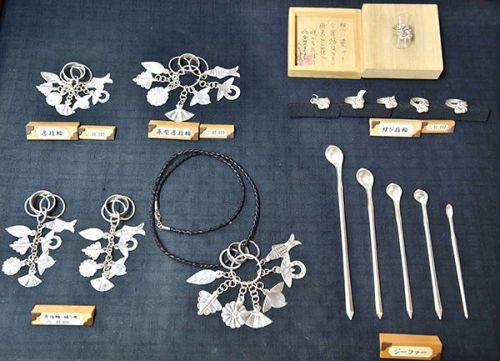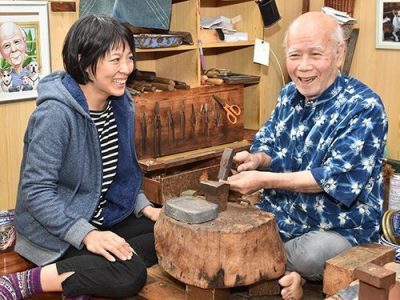What are fusa rings and jifas that Okinawa bestowed to Amuro-chan?

Goldsmith Kenjiro Matayoshi’s creations. Fusa rings and jifas towards the bottom right.
May 23, 2018 Ryukyu Shimpo (originally published on January 4, 2014)
By Kenichi Yoshida
On May 23, the Okinawa Prefecture bestowed the Prefectural Honor Award to singer Namie Amuro.
Besides a certificate of commendation, Okinawan handcrafted jewelry in the form of a fusa ring (traditional Okinawan ring) and a jifa (hairpin) were sent as souvenirs.
Exactly what are these and what sort of history do they have? Here we introduce an article on a craftsman who revived handcrafted Okinawan golden work.
“Ding, ding, ding” — The clanging of a hammer that has sounded since the Ryukyu Dynasty Era echoes throughout a workshop of just a little over 10 tatami mats (about 18.2 square-meters). Kenjiro Matayoshi, age 83, is the seventh owner of Kuganize~ku (goldsmithery) Matayoshi, a workshop in Ishimine Town of Shuri, Naha City.
He is also the only goldsmith in Okinawa that continues to create jifas and fusa rings.
A dignified Ryukyu woman stands with a jifa in her hair. A fusa ring’s seven charms that jingle.
A knot ring that etches two strings crisscrossing. All of which are elegant and charming.
The history of Okinawan goldsmithery goes back about 500 years.
During the Ryukyu Dynasty Era, many craftsmen had created all sorts of artwork.
However, due to the Battle of Okinawa, many tools and creations were lost and the history of goldsmithery disappeared from the center stage.
The one who had revived the artform was Kenjiro’s father and sixth owner, Seiboku.

Kenjiro Matayoshi, who followed his father’s footsteps and continues to create golden work, along with Natsuko Miyagi, who’s in her seventh year of apprenticeship on December 29, 2013 at Kuganize~ku Matayoshi in Ishimine Town of Shuri, Naha City.
As the fires of war grew more intense, Seiboku had grabbed several of his tools and left home, assuming Naha too would be hit by an airstrike one day.
Seiboku had left the workshop in Izumizaki, Naha City to Tomari, Tomari to Kinjo-cho of Shuri, then to Oku of Kunigami barely escaping with his life, but managed to protect the tools that were passed down from previous generations.
Tools that were left behind at the workshop were also retrieved after the war from what was left of the workshop, which was in burnt ruins.
Those tools today have been passed on to Kenjiro, who continues to create the same golden work his father used to make.
Kenjiro chisels in the same posture and rhythm as his father.
He said, “My father had mentioned that without proper feeling and posture, it would not take proper shape.”
Kenjiro said that there is no need for originality in goldsmithery.
Pursuing simplicity in the traditional form is how it has always been and should be.
He has even let go of apprentices that sought originality.
In the past, Kenjiro had worked for a radio station, but decided to become Seiboku’s apprentice at age 40 after wanting to “create something that will remain in time.”
Even now, he says that he “hasn’t reached his father’s skill level” and continues to devote himself every day to craftsmanship by taking the tools in hand his father has left him.Meanwhile, there are obstacles in passing down the craftmanship.One of which is a lack of successors. Right now, Kenjiro has three apprentices, but hopes to “pass down the technique to many people.”
Will the Okinawan technique that creates traditional beauty be passed on? In the meantime, Kenjiro will look to the future while continuing to chisel away, silently.
(English translation by T&CT and Chelsea Ashimine)
Previous Article:Large sculpture symbolic of buraku liberation sent from Osaka to its creator in Yomitan
Next Article:Namie Amuro wins Okinawa Prefectural People’s Honor Award
[Similar Articles]
- Akutagawa Award winner Naoki Matayoshi talks about writing that captures Okinawa’s atmosphere at the Ryukyu Forum
- Historical play – “Surrender of Shuri Castle”
- Golden Dragons, auspicious clouds on the pillars in Shurijo Castle
- Nine Japanese people left behind in the Philippines visit Japan
- National treasure from Ryukyu Kingdom era displayed
 Webcam(Kokusai Street)
Webcam(Kokusai Street)


